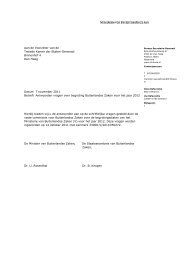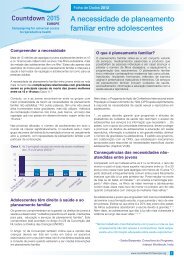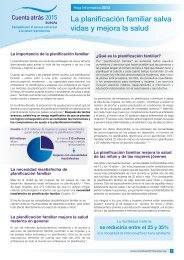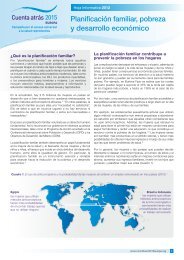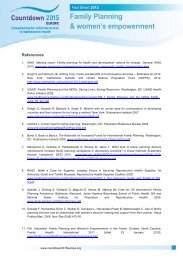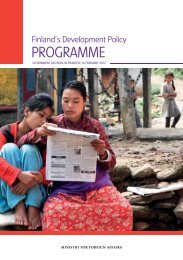The Unmet Need for Family Planning - Countdown 2015 Europe
The Unmet Need for Family Planning - Countdown 2015 Europe
The Unmet Need for Family Planning - Countdown 2015 Europe
You also want an ePaper? Increase the reach of your titles
YUMPU automatically turns print PDFs into web optimized ePapers that Google loves.
1 Overview: unmet need <strong>for</strong> family planning1.1 Levels of unmet needOne in four people in developing countries are women ofreproductive age (15-49). Among these women, 867 million ofthem want to avoid a pregnancy completely or space or limitfuture pregnancies (Singh, Darroch et al. 2012; USAID 2009).Despite these desires, 222 million of them are not using any <strong>for</strong>mof modern contraceptive.<strong>The</strong>se 222 million women have an unmet need <strong>for</strong> moderncontraception (Singh, Darroch et al. 2012). <strong>The</strong>y are women whoare using either traditional methods of family planning, whichhave been shown to have high failure rates (Singh, Darroch et al.2009) or no method at all.1.2 Reasons <strong>for</strong> unmet needQuick Facts: what is unmet need?Women and girls have an unmet need <strong>for</strong> family planning when theyare sexually active and wish to avoid a pregnancy completely, orspace or limit future pregnancies, but are not using a modern <strong>for</strong>mof contraception.••867 million women in developing countries want to avoidpregnancy••645 million are using modern contraceptives••222 million are not using any <strong>for</strong>m of modern contraceptive<strong>The</strong>se 222 million women have an unmet need <strong>for</strong> moderncontraception. This is due in part to the fact that many do not haveaccess to an effective, af<strong>for</strong>dable family planning programme.Source: (RHSC 2009; Singh, Darroch et al. 2012)<strong>The</strong>re are individual reasons why women do not use modernmethods of contraception. <strong>The</strong>se can be influenced by social,cultural or political factors, such as a lack of support <strong>for</strong> familyplanning in a woman’s family or social or religious community, ora lack of family planning policies and, there<strong>for</strong>e, limited access toin<strong>for</strong>mation, supplies and services.According to data reported by the Guttmacher Institute (Sedgh,Hussain et al. 2007), unmet need <strong>for</strong> family planning at the individual,family or community level is largely attributed to the following:••Low perception of risk – Woman perceive that they are atlow risk of getting pregnant – <strong>for</strong> example, due to infrequentsexual activity or because they have recently given birth orare breastfeeding and believe this will adequately protectthem from pregnancy.••Inadequate access to supplies and services – Inadequateavailability of contraceptive supplies and/or health services,including lack of knowledge about contraceptive methods;problems accessing contraception (including cost, notknowing a source and not being able to get to a care facility);and problems related to side-effects, health concerns, anddifficulties or inconvenience in using methods.••Opposition – Refusal of family planning, either on thewoman’s part or on the part of her partner or anotherinfluential person, including opposition on religious grounds(Sedgh, Hussain et al. 2007)An analysis of 13 developing countries found that a significantnumber of women do not have adequate knowledge aboutcontraception, have health concerns about using moderncontraception or could not af<strong>for</strong>d or easily obtain contraceptivesupplies or services (Sedgh, Hussain et al. 2007).At the broader political level, the lack of access to suppliesand services could be associated with reductions in politicalcommitment and funding <strong>for</strong> family planning in recent decades.For example, restrictions on funding <strong>for</strong> reproductive healthby the US government during the presidency of George W.Bush (i.e., the Mexico City Policy or ‘Global Gag Rule’) ledto dramatic cuts in money available <strong>for</strong> family planning <strong>for</strong> anumber of years. While these restrictions are no longer in place,they led to cuts in services in many countries, which is likely tohave contributed to increasing unmet need <strong>for</strong> family planning(Lancet/UCL 2009).In addition, reductions in funding may have come about due tothe belief by donors that family planning is already fully funded.In part, the success of family planning programmes has led tothis false belief. Also, while there have been large increasesin funding to ‘population’ budget lines, much of this hasgone towards HIV/AIDS (Lancet/UCL 2009) rather than familyplanning. <strong>The</strong> lack of transparency in budget lines and thelack of a dedicated budget line specifically <strong>for</strong> family planninghave led to a false confidence that family planning has receivedadequate funds.8 www.countdown<strong>2015</strong>europe.org




